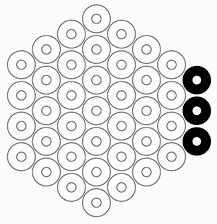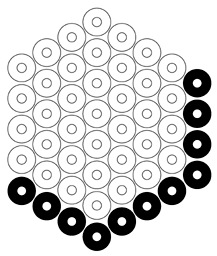|

As for adding potentials to GIPF, adding extra
rings to ZÈRTZ is an option! Starting to play ZÈRTZ
on an enlarged board only makes sense if you have first mastered the
basic strategies. If you are not familiar with long sequences of moves
(e.g. forcing your opponent to six, seven and even more consecutive
captures to obtain the marbles you want) we advise you not to use
extra rings; it would just mean that it takes longer before you reach
an interesting situation on the board. In other words: if you are
not an experienced ZÈRTZ-player, adding rings to ZÈRTZ
makes the game boring - and that is not the purpose. ZÈRTZ
has more than enough depth as it is.
However...
|

|
... if you know well
how to control marbles on the board and see the moves to get
them where you want them to be, then you may find an extra challenge
in making the board larger. Start with 3 extra rings; 3 extra
rings don't add that much complexity, but, because of the irregular
hexagonal shape, they make it possible to play more different
opening moves. |

|
If you want to go further
you can play with 7 extra rings... |
|

|
...
or even with 11. The more rings, the harder it will become to
find the solutions you are looking for.
|
|
Note 1: you don't need
extra marbles; the number of marbles and the conditions to
win remain unchanged.
Note 2: you'll find a
12th rings in GIPF Set 2. That is a spare piece. And you may
need it if you have two Sets 2 and want to play ZÈRTZ
with 24 extra rings.
Note 3: some advanced
players don't exclude that the definite version of ZÈRTZ
will be played on a board with 61 rings (i.e. with 24 rings,
indeed). You are warned!
|
|
|